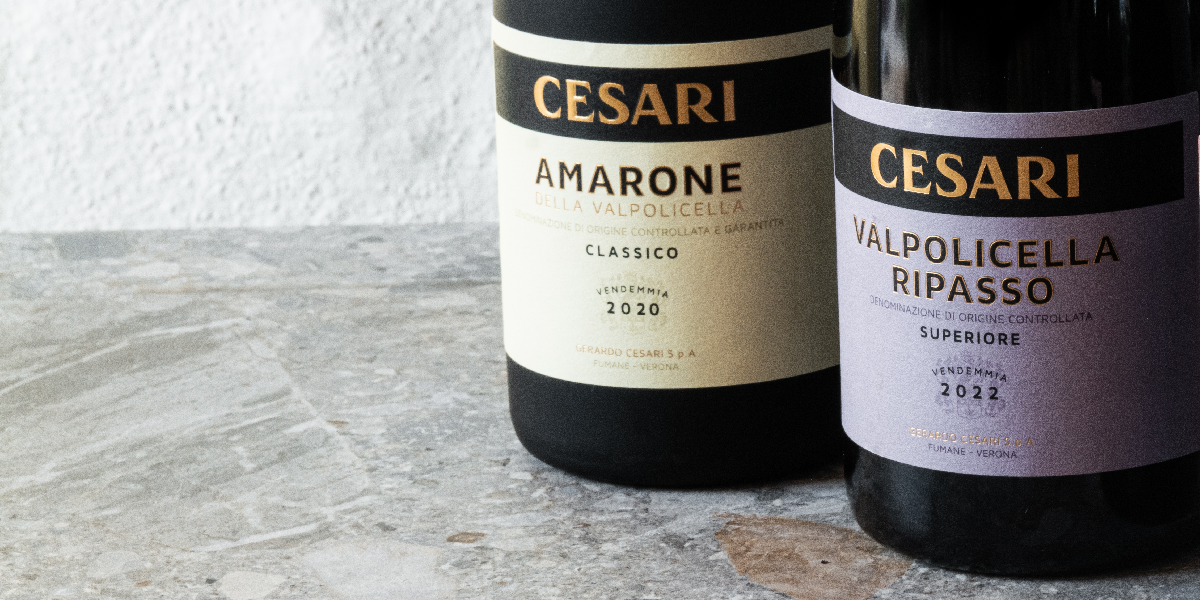Amarone and Ripasso: Differences and Similarities

Discover the key differences and similarities between Amarone and Ripasso—two iconic wines from Valpolicella, each with its own unique characteristics, pairings, and stories.
The Valpolicella region, a picturesque hilly area near Verona, is renowned for producing premium wines that reflect the tradition and quality of the local terroir. Among its most emblematic expressions, Amarone della Valpolicella and Valpolicella Ripasso stand out. In this article, we explore what sets them apart—and what brings them together—to help wine lovers understand their distinctive identities.
Similarities Between Amarone and Ripasso
- Geographic origin: Both wines are produced in Valpolicella, a predominantly hilly area near Verona, internationally celebrated for its winemaking tradition.
- Grapes used: Amarone and Ripasso share the same key native grape varieties: Corvina, Corvinone, and Rondinella—symbols of the region’s winemaking identity.
- Rich, full-bodied character: These two reds are known for their structure, aromatic intensity, and aging potential.
- Traditional winemaking techniques: Both wines are crafted using time-honored methods that involve careful vinification and attention to detail.
At Cesari, these two parallel expressions are interpreted as distinct opportunities to tell the story of the land through tradition, while embracing a contemporary and forward-looking spirit.
Key Differences Between Amarone and Ripasso
- Production method:
- Amarone is made from partially dried grapes, which gives the wine its deep concentration and intensity.
- Ripasso is produced using the “ripasso” technique—where Valpolicella Classico wine is refermented on the pomace of Amarone, enriching its body and aroma.
- Alcohol content: Amarone has a higher alcohol content than Ripasso, making it more powerful and structured.
- Price: Due to its longer and more complex production process, Amarone typically commands a higher price than Ripasso.
When to Enjoy Each Wine
- Amarone is ideal for special occasions or to be savored on its own as a meditation wine.
- Ripasso is more versatile and well-suited to casual gatherings and less formal pairings.
Food Pairings
- Amarone pairs beautifully with game, braised meats, aged cheeses, and rich dishes. It also shines as a meditation wine, especially when paired with dark chocolate or cocoa-based desserts.
- Ripasso complements red meats, flavorful pasta dishes, lasagna, and semi-aged cheeses. It’s a more “versatile” wine, perfect for a wide range of occasions.
The story behind Amarone and Ripasso
Historical origins
Amarone della Valpolicella is famously known as a “wine born by mistake.” Legend has it that a cellar master accidentally forgot some barrels of Recioto wine in the cellar. Over time, the fermentation continued until all residual sugars were converted into alcohol, resulting in a dry, full-bodied wine. Not just “amaro” (bitter), but “Amarone”—meaning intensely bitter. This happy accident is attributed to cellar master Adelino Lucchese in the early 20th century. amaro. Questa fortuita svista è attribuita al cantiniere Adelino Lucchese, a inizio Novecento.

The first references to Ripasso date back to medieval documents, although it only began to be known by its modern name in the late 19th century. In modern times, its vinification is closely linked to that of Valpolicella Classico and Amarone.
The Ripasso Technique
This method efficiently utilises Amarone pomace, enabling winemakers to craft a rich, full-bodied wine with minimal waste. At Cesari, the production of Ripasso begins with the crushing and fermentation of the base Valpolicella wine.
This base is then “passed over” the Amarone pomace for 10 days, followed by a second fermentation. After an initial aging phase, the wine is bottled and undergoes final bottle aging.
Amarone and Ripasso: Two Wines, One Passion
Amarone and Ripasso represent two sides of the same coin, offering unique sensory experiences that reflect the richness of Valpolicella wines.
We invite you to visit our winery and taste both wines to discover which best suits your palate and your favorite moments of enjoyment.
